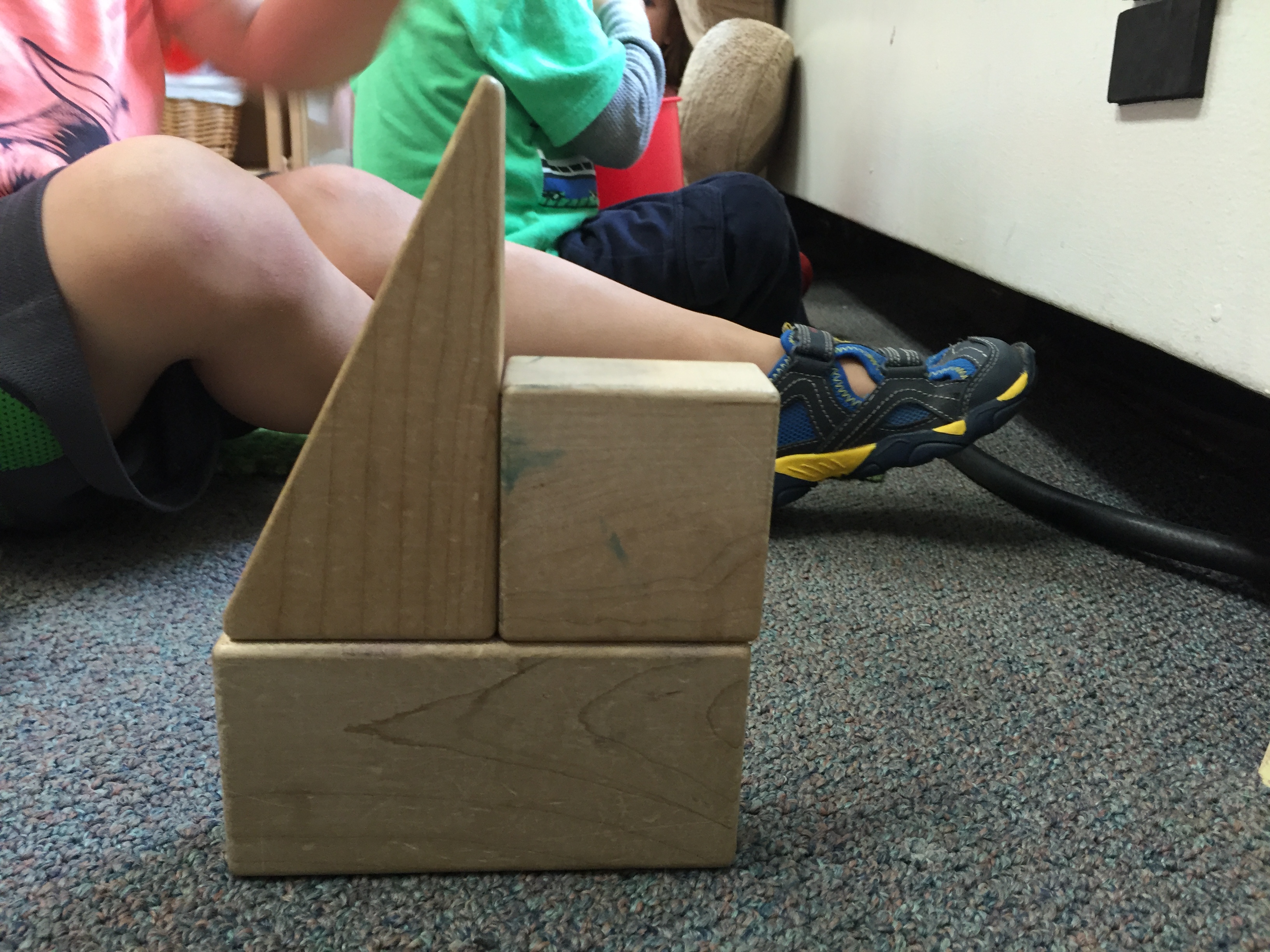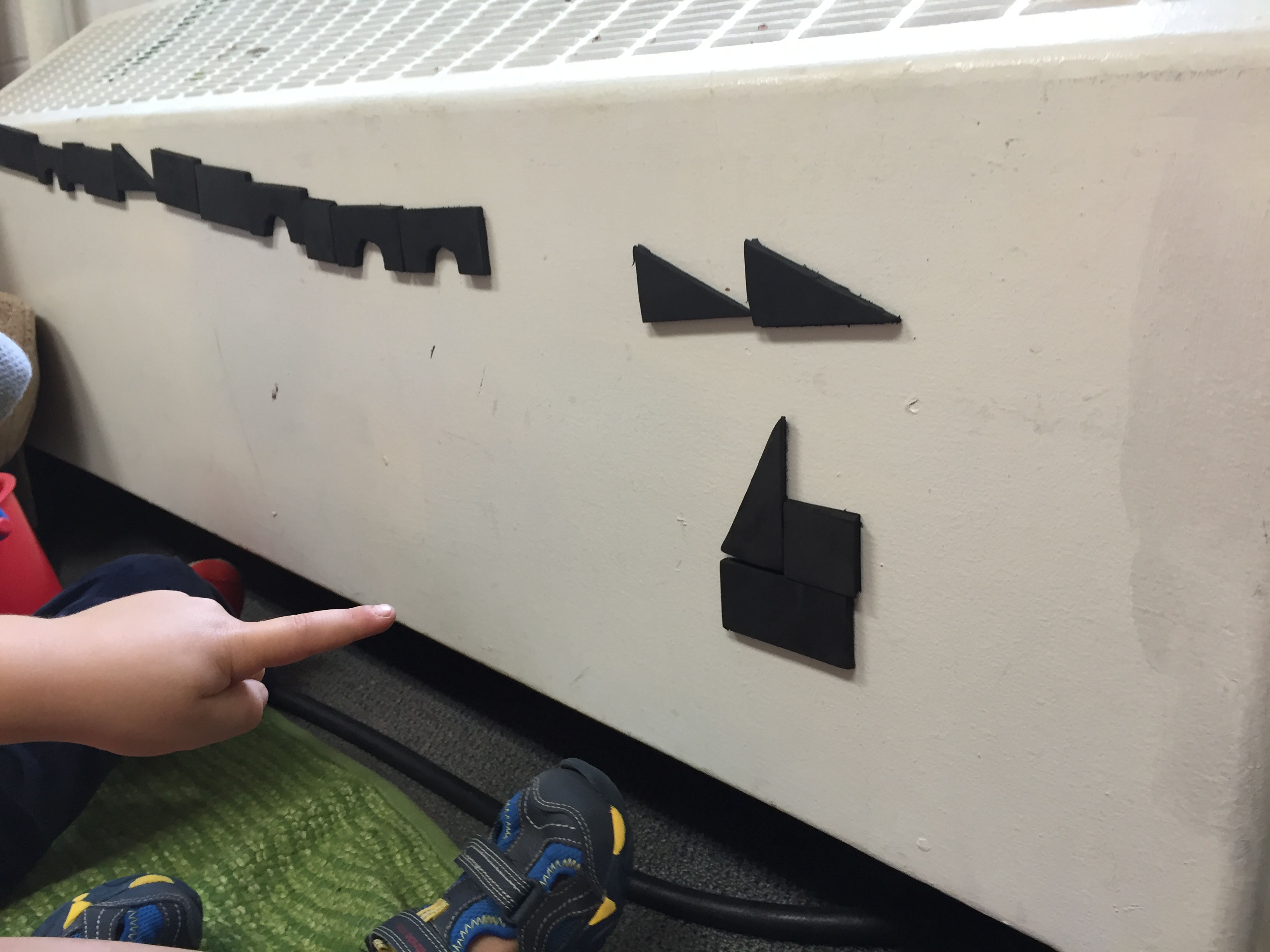Manipulating Contents & Containers, and representing 3-D objects in block play
By Peggy Ashbrook
Posted on 2016-07-29
It is so fascinating how obvious it is that children have different prior experiences, different developmental ages, and different interests when we teachers present them with a set of materials and don’t ask them to use them in a particular way! This post is a reflection on how two different sets of objects are used by preschool children ages 3-5 years. The experiences I describe are just the beginning of explorations into the relationship between “contents” and “containers,” and the way 2-D materials can represent 3-D structures.
Contents and containers
 I had the pleasure of working with two classrooms on building with a variety of materials, a class of young-to-old three-year-olds and a mixed age classroom of just-four-year-olds to older five-year-olds. We teachers provided a set of “contents and containers” to both classes, inspired by presentations by Dr. Rosemary Geiken and Dr. Jill Uhlenberg (Geiken 2009).
I had the pleasure of working with two classrooms on building with a variety of materials, a class of young-to-old three-year-olds and a mixed age classroom of just-four-year-olds to older five-year-olds. We teachers provided a set of “contents and containers” to both classes, inspired by presentations by Dr. Rosemary Geiken and Dr. Jill Uhlenberg (Geiken 2009).
The contents we used were balls of different sizes, film canisters, cotton balls, and lids from various jars and bottles. The containers were made-for-food-storage plastic tubs, recyclable oatmeal/coffee canisters and cans, plastic netting from fruit, plastic cups, and sections of drainage tubes. I chose these objects because they were easy to access and could fit together in more than one way. Our purpose was to observe the children to understand more about what interests them and their approach to new materials.
 In both classrooms there was a variety of approaches: some children collected as many of the “contents” as they were able to, many explored the way the contents fit into the various containers and how the containers could open and close, some tried making a system to move the contents into and between the containers, and others used the objects to make sounds or as part of imaginative play. They encountered problems to struggle with and sometimes solve: there wasn’t enough room in the container for all the collected contents, an object got stuck inside a container, two containers got stuck together, and there weren’t enough of the coveted objects to satisfy all who wanted them.
In both classrooms there was a variety of approaches: some children collected as many of the “contents” as they were able to, many explored the way the contents fit into the various containers and how the containers could open and close, some tried making a system to move the contents into and between the containers, and others used the objects to make sounds or as part of imaginative play. They encountered problems to struggle with and sometimes solve: there wasn’t enough room in the container for all the collected contents, an object got stuck inside a container, two containers got stuck together, and there weren’t enough of the coveted objects to satisfy all who wanted them.
We could see which children needed support to persist, and were able to use open-ended prompts (statements from teachers) to support children in trying alternative solutions. Over the weeks of using the materials the children began using them with other classroom materials, finding new purposes for both contents and containers, and new problems to solve. Beginning with a set of materials that could be used in many ways allowed us to really see what developed, because we didn’t have an expectation of how the children should use them. The play that sprang forth reminded me of the play that happens in workshops by Dr. Walter Drew (see video examples) and his work with co-authors Dr. Marcia Nell and Dr. Baji Rankin.
Using 2-D shapes to represent 3-D structures
When we do ask children to use materials in a particular way, their different prior experiences, different developmental ages, and different interests also become apparent. We can use this information to guide our lesson planning and discussions about children’s work.
A teacher shared her previous experience of making the 3-D unit block shape cross-sections in the medium of 2-D art foam with magnetic backing to be used on a radiator or white board. We made a set based on the blocks available in the classrooms and asked children to build with a small set of blocks and then represent their structure using the 2-D art foam blocks. We hope that children will later use the foam blocks to represent the 3-D structures they want to save and reflect on after the 3-D blocks are put away.
This was a new material for most of the children so we expected them to be mostly interested in using the art foam block shapes. A few children in both age groups created small wooden unit block shapes and then used the 2-D art foam shapes to represent the structure.
 They looked back and forth between their unit block structure and their art foam block representation on the wall. A child who was trying to make a symmetrical structure with a triangle block on either side of a central rectangular block was frustrated by the lack of triangle blocks that faced both ways. It quickly became apparent that I had only made “right-handed” triangle blocks, sticking the magnetic backing to the triangles when they were all facing the same way! Luckily I had additional material and could correct this omission. But the situation allowed us to assess that the child was very aware of the direction of her triangle block.
They looked back and forth between their unit block structure and their art foam block representation on the wall. A child who was trying to make a symmetrical structure with a triangle block on either side of a central rectangular block was frustrated by the lack of triangle blocks that faced both ways. It quickly became apparent that I had only made “right-handed” triangle blocks, sticking the magnetic backing to the triangles when they were all facing the same way! Luckily I had additional material and could correct this omission. But the situation allowed us to assess that the child was very aware of the direction of her triangle block.
 Some children began building a long “train” of the 2-D art foam blocks and others wanted to see how many of the art foam blocks it took to cover a set of unit blocks lying on the floor. The idea of representing a 3-D block structure may become important another day if they want to save a particular structure to use the following day but space requirements don’t allow structures to stay up during nap time. A 2-D representation can help children remember what blocks they used so they can recreate the structure and perhaps redesign it.
Some children began building a long “train” of the 2-D art foam blocks and others wanted to see how many of the art foam blocks it took to cover a set of unit blocks lying on the floor. The idea of representing a 3-D block structure may become important another day if they want to save a particular structure to use the following day but space requirements don’t allow structures to stay up during nap time. A 2-D representation can help children remember what blocks they used so they can recreate the structure and perhaps redesign it.
It will be interesting to see if using the 2-D foam block shapes has any influence on whether childr
en choose to draw their 3-D wooden block structures on paper, and how easy it is for them to document and represent their structures in yet another medium.
Geiken, R., Uhlenberg, J., Uhlenberg, D, & York, C. (November 2009). Toddlers engaged in inquiry and problem solving: Promoting learning in science and math with spheres and cylinders. National Association for the Education of Young Children National Conference, Washington, DC Conference session
Drew, Walter F. and Baji Rankin. 2004. Promoting Creativity for Life Using Open-Ended Materials. Young Children July 2004
Nell, Marcia L., and Walter F. Drew, With Deborah E. Bush. 2013. From Play to Practice: Connecting Teachers’ Play to Children’s Learning. NAEYC
Disclaimer: The views expressed in this blog post are those of the author(s) and do not necessarily reflect the official position of the National Science Teaching Association (NSTA).






